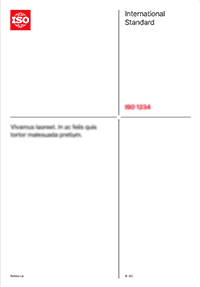Resumen
This document provides information regarding the measurement and evaluation of the mechanical vibration of wind turbines and their components. The working principles of wind turbines covered by this document are described in Annex B.
The installation site and type of mechanical drive train of the wind turbine influence the vibration magnitude, so for the purposes of this document wind turbines have been divided into two groups:
a) Group 1: Horizontal axis wind turbine installations with generators coupled to the rotor via a gearbox; and
b) Group 2: Horizontal axis wind turbine installations with generators coupled to the rotor without a gearbox (direct drive wind turbines).
The requirements of this document apply to both Group 1 and Group 2 wind turbines with a rated generator output exceeding 200 kW.
This document recommends zones for evaluating the vibration at continuous load operation. However, in most cases these evaluation zone boundaries are not suitable for the early detection of faults. Annex A presents evaluation zone boundaries based on vibration data collected from thousands of wind turbines with rated generator outputs of 5 MW or less, which can be helpful in facilitating discussion between users and manufacturers when considering early fault detection.
The evaluation criteria described in this document serve to ensure safe, reliable, long-term operation of the wind turbine and its components. It is intended to standardize the vibration measurements taken, to assist in their evaluation and to facilitate a comparative evaluation of the vibration measured in wind turbines and their components. In addition, recommendations are given for the determination of operational vibration limit values.
The type and implementation of broad-band vibration monitoring methods to be used for wind turbines are addressed in this document, along with evaluation criteria for assessing vibration severity. This document does not address diagnosis or fault detection, although the measurement equipment described can be used for vibration monitoring.
NOTE 1 For information regarding vibration condition monitoring see the ISO 13373 series. For Information regarding condition monitoring and diagnostics of wind turbines see the ISO 16079 series.
NOTE 2 IEC 61400-13 describes load measurements that can be taken using strain gauges mounted on the wind turbine support structure and blades. For procedures to assist the detection of rolling bearing and gearbox defects see ISO 13373-2. For the measurement and evaluation of structure-borne noise in wind turbines fitted with rolling bearings see VDI 3832.
NOTE 3 Evaluation of the unbalance of the slowly turning wind turbine rotor requires the use of measurement techniques and analysis which consider both mass and aerodynamic unbalance. To assess the influence of the rotor unbalance on vibrations see VDI 3834-1:2015-08, Annex B.
The requirements described in this document do not apply to the acceptance measurements for wind turbine gearboxes and generators taken in the manufacturer’s test facility.
NOTE 4 Acceptance measurements for wind turbine gearboxes and generators, taken in the manufacturers test facility, are assessed as described in ISO 20816-9 and/or IEC 60034-14.
This document does not provide evaluation zones for vibration measurements taken on rotating parts (shaft relative displacement) due to the small number of turbines on which such measurements are/have been taken.
Informaciones generales
-
Estado: En desarrolloFecha de publicación: 2025-05Etapa: Norma Internacional en proceso de publicación [60.00]
-
Edición: 1
-
Comité Técnico :ISO/TC 108/SC 2
- RSS actualizaciones
Ciclo de vida
-
Anteriormente
PublicadoISO 10816-21:2015
-
Ahora


